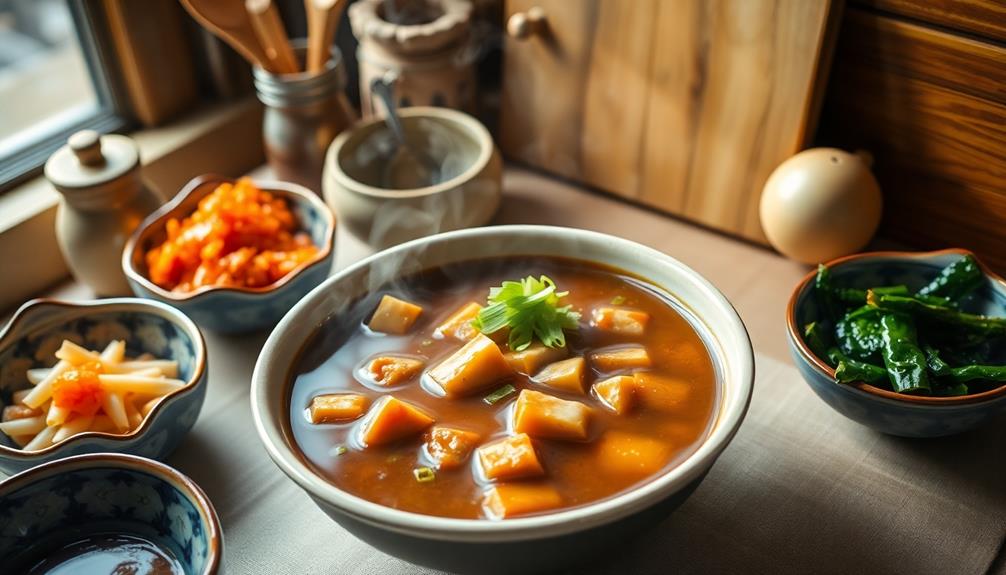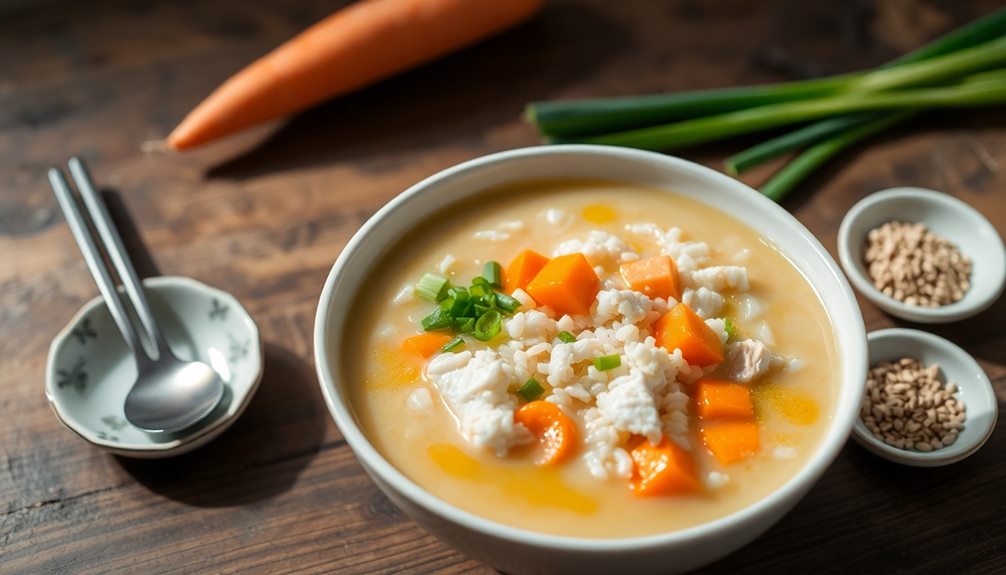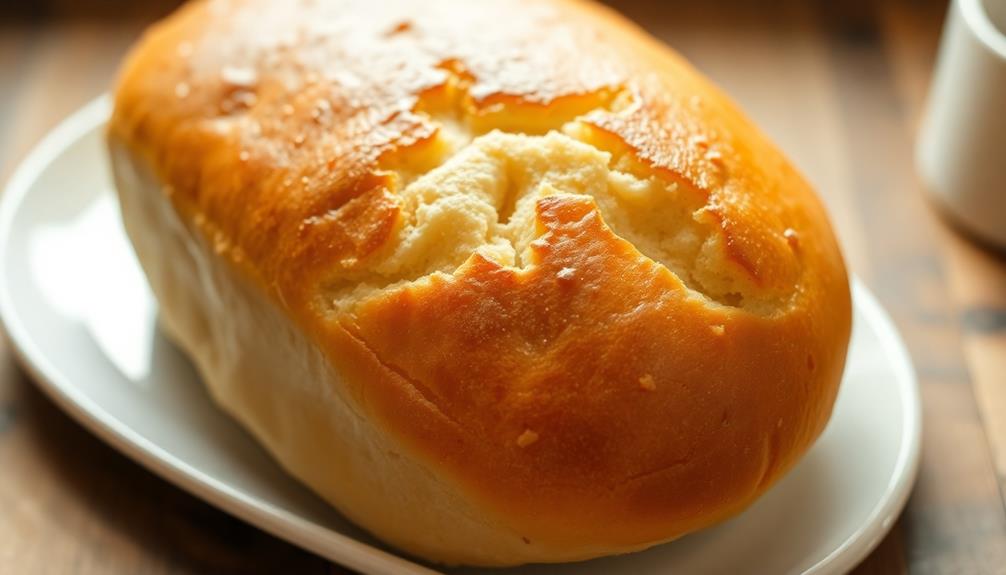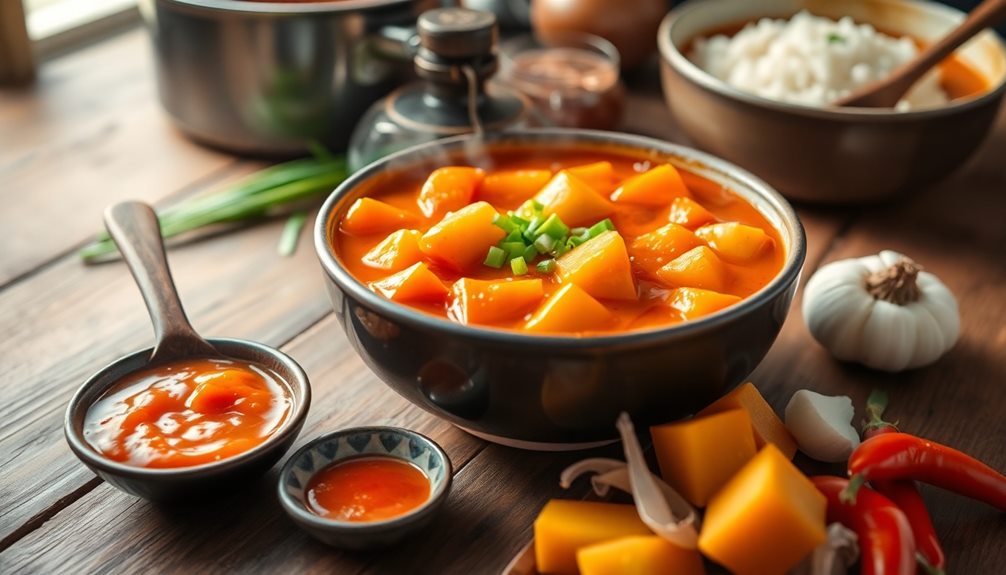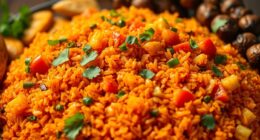Doenjang jjigae is a yummy Korean stew that's all about comfort! With delicious fermented soybean paste as its star, it's packed with flavors that warm your heart and fill your tummy. You'll love how easy it is to make—just gather some tofu, onions, zucchini, and even a bit of meat if you'd like. After boiling water, mix in the soybean paste and let everything simmer until it's nice and tender. The smell will make your kitchen feel cozy! It's not just a meal; it's a tradition that brings people together, and there's more to discover about this special dish! If you enjoy the rich flavors of doenjang jjigae, you might also want to try making a jajangmyeon recipe. Jajangmyeon is a popular Korean noodle dish made with black bean sauce and various vegetables, and it’s just as comforting and delicious as doenjang jjigae. Both dishes are perfect for sharing with loved ones and creating unforgettable memories around the dinner table. So why not expand your culinary horizons and give the jajangmyeon recipe a try? You might just discover a new favorite comfort food!
Key Takeaways
- Doenjang jjigae is a traditional Korean stew made primarily with fermented soybean paste, known for its rich umami flavor and health benefits.
- The dish typically includes ingredients like tofu, onions, and zucchini, and can be customized with various vegetables and proteins.
- Preparation involves boiling water, dissolving doenjang, and simmering ingredients until tender, filling the kitchen with a savory aroma.
- It serves as a comforting communal meal, often enjoyed with rice, reflecting Korean culinary heritage and family values.
- Nutritionally, it is rich in protein, vitamins, and probiotics, making it a wholesome and satisfying meal option.
History
Doenjang jjigae, a staple in Korean cuisine, has a rich history that dates back centuries. This delicious stew, made with fermented soybean paste, captures the hearts of many with its warm flavors and comforting texture. Imagine sitting around a table with your family, sharing stories while enjoying a bowl of this savory dish!
You might be surprised to learn that doenjang, the key ingredient, has been around since ancient times. It was often made at home, using traditional methods passed down through generations. People treasured it not just for its taste, but also for its health benefits. In fact, the fermentation process makes it packed with nutrients!
As you dive into the history of doenjang jjigae, you'll discover that it's more than just a meal; it's a part of Korean culture. It symbolizes the love and care that families share, often made with seasonal vegetables and meat, reflecting the ingredients available at the time.
Recipe
Doenjang Jjigae, a traditional Korean soybean paste stew, is a hearty and flavorful dish that embodies the essence of Korean home cooking. This comforting stew is known for its rich umami flavor, derived from doenjang, a fermented soybean paste that serves as the base of the dish.
It's often prepared with a variety of vegetables, tofu, and sometimes meat, making it a versatile meal that can be customized to your liking. The simplicity of the ingredients allows the doenjang to shine, creating a satisfying stew that warms both the body and soul.
Making Doenjang Jjigae is an uncomplicated process that requires minimal prep work, making it perfect for both novice and experienced cooks. The stew is typically served alongside a bowl of steaming rice, and its savory aroma will fill your kitchen as it simmers.
In just a short amount of time, you can enjoy this delicious dish that showcases the flavors of Korean cuisine.
Ingredients:
- 4 cups of water
- 1/2 cup of doenjang (Korean soybean paste)
- 200g firm tofu, cut into cubes
- 1 medium onion, sliced
- 2 medium zucchini, sliced
- 2-3 green chili peppers, sliced
- 2-3 cloves garlic, minced
- 1 cup of mushrooms (shiitake or button), sliced
- 2 green onions, chopped
- Optional: 100g of pork or beef, thinly sliced
- Salt to taste
In a large pot, bring 4 cups of water to a boil. Once boiling, add the doenjang and stir well to dissolve. If using meat, add it at this stage and let it cook for about 5 minutes.
Next, add the sliced onion, zucchini, green chili peppers, garlic, and mushrooms to the pot. Allow the stew to simmer for about 10-15 minutes until the vegetables are tender.
Finally, gently add the tofu cubes and let them cook for an additional 5 minutes. Adjust the seasoning with salt if needed, and sprinkle chopped green onions on top before serving.
When cooking Doenjang Jjigae, feel free to adjust the ingredients based on what you have available. You can substitute or add other vegetables like radish or spinach, and the amount of doenjang can be modified to suit your taste preferences.
For added depth of flavor, consider using homemade stock instead of water. Always remember to taste as you go, ensuring the balance of flavors is just right for your palate. Enjoy your warm, comforting bowl of stew!
Cooking Steps
Before you start cooking your Doenjang Jjigae, it's super helpful to prepare all your ingredients ahead of time.
Chop those vegetables into bite-sized pieces so they cook just right, and then you can add water to your pot and bring it to a boil.
Once it's bubbling, stir in the doenjang, let everything simmer, and soon you'll have a delicious stew ready to enjoy!
Step 1. Prepare Ingredients Beforehand
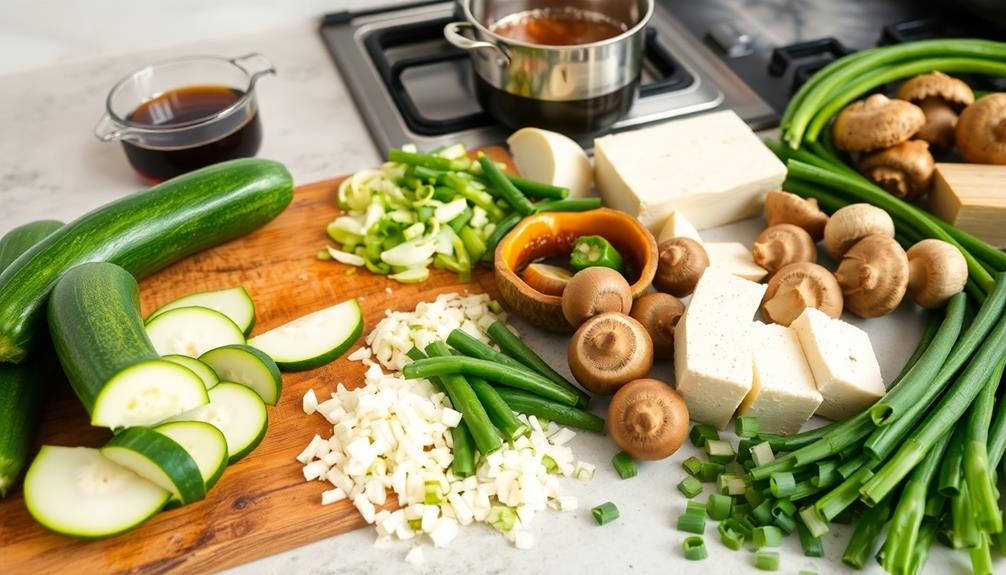
Getting everything ready is essential for a smooth cooking experience. Before you start making your delicious Doenjang Jjigae, gather all the ingredients you'll need. This makes cooking much easier and way more fun!
First, you'll want to measure out your soybean paste—about two tablespoons should do the trick. Next, grab some water or broth, as this will be the base of your stew.
Don't forget to have your tofu ready! You'll need about a cup, so cut it into cubes. If you're adding mushrooms, green onions, or zucchini, make sure you have those on hand too. It's like assembling a superhero team, each ingredient has its special power!
Also, grab your cooking pot and spatula. Having everything in one place helps avoid any last-minute scavenger hunts in your kitchen. It's like a treasure hunt, but you'll find ingredients instead of gold!
Lastly, don't forget to wash your hands! Clean hands are super important when cooking.
Once you've got everything prepped and ready to go, you'll be all set to create a comforting, tasty Doenjang Jjigae that everyone will love!
Step 2. Chop Vegetables Into Bite-Sized Pieces
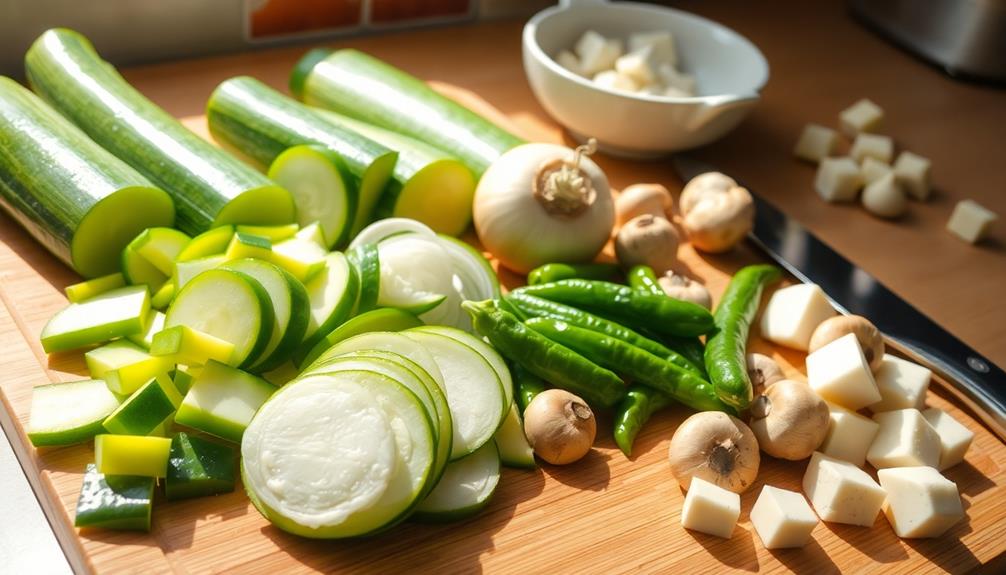
Now that you've gathered all your ingredients, it's time to chop the vegetables into bite-sized pieces. This step is super important because it makes everything cook evenly, and it's easier to eat later. Grab your cutting board and a sharp knife—safety first!
Start with the onions; slice them in half, then chop them into small pieces. Don't worry if you shed a few tears—onions have that effect!
Next, move on to the zucchini. Slice it into rounds and then cut those rounds into quarters. This way, they'll fit perfectly in each spoonful.
For the mushrooms, remove the stems and slice them into thin pieces. They'll add a nice texture to your stew.
And let's not forget about the green onions! Simply chop them into small pieces too, and save the green tops for garnish later.
Step 3. Add Water and Bring to Boil
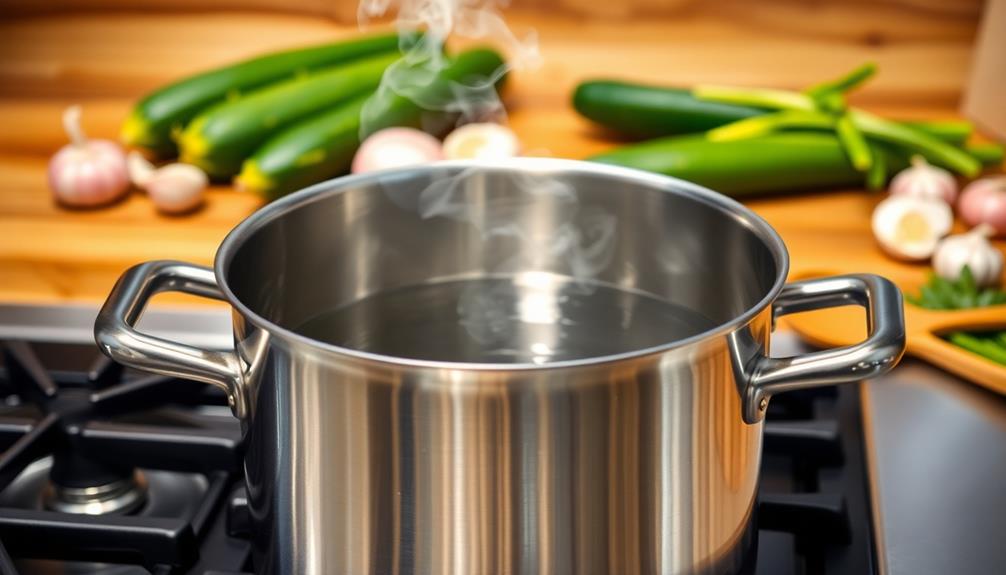
Pouring water into your pot, you'll want to add enough to cover the vegetables by about an inch. This is super important because it helps everything cook evenly and makes your stew nice and hearty!
Once you've added the water, place your pot on the stove and turn the heat to high. You'll want to keep an eye on it, so you don't miss that magical moment when it starts to boil.
As the water heats up, you might hear it gurgling and bubbling—just like the pot is telling you, "I'm ready!" Stir the ingredients gently every now and then, so they don't stick to the bottom. You might notice the colors of the veggies brightening up as they soak in all that hot goodness. Isn't that fun?
Once you see those first bubbles breaking the surface, you know you're on the right track! It usually takes about 10 to 15 minutes for your pot to reach a full boil, depending on your stove.
Step 4. Add Doenjang and Stir
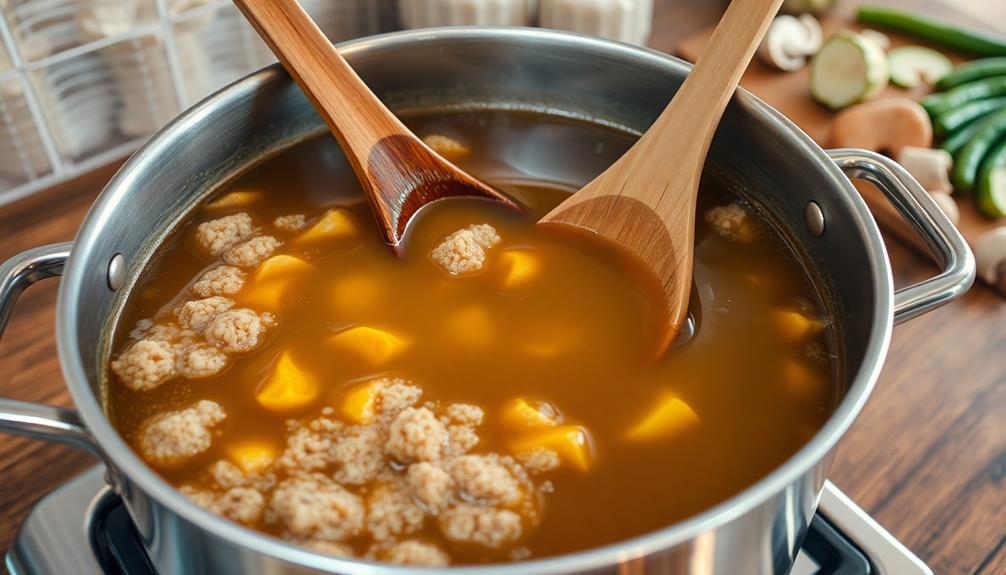
Once your water is boiling, it's time to add the star ingredient: doenjang. This rich, savory soybean paste is what makes doenjang jjigae so special! Grab a spoon and scoop out about three tablespoons of doenjang. If you want a stronger flavor, feel free to add a little more.
Now, carefully drop the doenjang into the bubbling pot, and watch it swirl into the water, like a superhero diving into action!
Once the doenjang is in, it's time to stir! Use a spoon to mix it well, making sure the paste dissolves completely. You don't want any big clumps floating around; they can be a bit too salty.
Stirring helps the flavors blend together, and soon you'll smell that amazing aroma filling your kitchen!
As you stir, feel free to taste a little of the broth. If it's not quite perfect yet, you can adjust the seasoning by adding a pinch of salt or a dash of soy sauce.
Step 5. Simmer Until Vegetables Are Tender
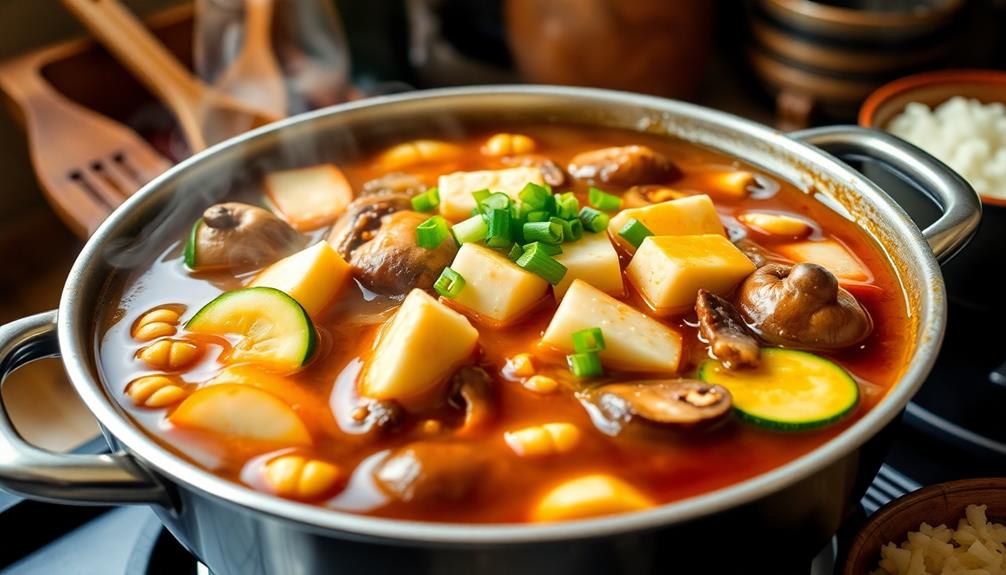
With the doenjang fully dissolved, it's time to let your ingredients mingle and soften. Bring the pot to a gentle simmer. This is where the magic happens! You'll want to cook everything for about 15 to 20 minutes. Keep an eye on it, so the stew doesn't boil too hard; we want a cozy simmer, not a wild party!
As the stew cooks, the vegetables will start to change. Carrots, zucchini, and mushrooms will soften and soak up all those delicious flavors from the doenjang. You might notice the aroma filling your kitchen—trust me, it'll make you hungry!
If you're using tofu, it's best to add it around the halfway mark. This way, it absorbs some of that yummy broth without falling apart.
Every now and then, give the stew a gentle stir to keep everything moving. You'll know it's ready when the vegetables are tender but still hold their shape. Imagine taking a big spoonful of that rich, flavorful broth with soft veggies and tofu—yum! Your doenjang jjigae is almost ready, and you're just a few steps away from a delicious meal!
Final Thoughts
As you wrap up your culinary adventure with doenjang jjigae, it's clear that this rich and hearty stew offers more than just a meal; it's a comforting embrace from Korean cuisine.
You've not only learned how to make this dish, but you've also discovered a piece of culture that warms the heart. With each ingredient you added, from the savory doenjang to the fresh veggies, you created a symphony of flavors that dance on your taste buds.
Imagine sitting down with family or friends, sharing bowls of steaming doenjang jjigae, and letting the delicious aroma fill the air.
It's the perfect dish for chilly days or when you just need a little pick-me-up. Plus, you can customize it to your liking! Want more spice? Toss in some chili peppers! Prefer it vegetarian? Skip the meat and add extra mushrooms!
Frequently Asked Questions
What Are Common Variations of Doenjang Jjigae?
When exploring variations of a popular dish, you'll often find regional ingredients, different proteins like tofu or seafood, and additional vegetables. Each twist offers a unique flavor, making your culinary experience richer and more exciting.
Can I Use Store-Bought Doenjang?
Yes, you can definitely use store-bought doenjang. It's convenient and saves time. Just make sure to taste it first, as quality can vary. You might need to adjust the seasoning to suit your dish.
Is Doenjang Jjigae Vegan-Friendly?
Yes, it can be vegan-friendly! Just ensure you use vegetable broth and avoid any meat or seafood ingredients. By choosing plant-based options, you can enjoy a delicious, hearty stew without compromising your dietary preferences.
What Side Dishes Pair Well With Doenjang Jjigae?
When enjoying a hearty stew, you'll love pairing it with banchan like kimchi, pickled radishes, or seasoned spinach. These sides enhance the flavors and add a delightful crunch to your meal experience.
How Should I Store Leftover Doenjang Jjigae?
To store leftovers, let the dish cool to room temperature. Then, transfer it to an airtight container and refrigerate. It'll stay fresh for up to four days. Reheat thoroughly before enjoying again!
